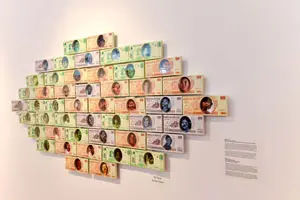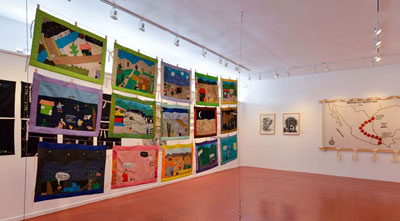



The beginning of Latino History Month, slated Sept. 15 to through Oct. 15, will be marked at Fredonia with a discussion of immigration and include an exhibit of textiles and artwork.
 |
While debates about the United States’ response to incoming migrants are extremely important, discussion will turn the tables, asking questions like ‘What happens to the vibrant and ancient indigenous cultures of Latin American regions when up to 70 percent of villages are left empty?’ and ‘Who will teach the young about the plantings and the specific culture of dance, music, and crafts?’
Immigration is a significant issue for the Fredonia region. According to Lucia Johnson, project director of the Fredonia Migrant Educational Opportunity Program (MEOP), there are several hundred children and adults of Mixtec background in the Chautauqua County region. They came here from Oaxaca and provide much of the agricultural labor in our fields.
Marietta Bernstorff has curated “Nuevo Códice: Oaxaca Migrción y Memoria Cultural” (“New Codex: Oaxaca Immigration and Cultural Memory”), an exhibit of textiles and other artwork which engages with the impact of outmigration on Oaxacan communities. Originally from Chiapas, the southernmost state of Mexico, she grew up in Mississippi and eventually ended up in Arizona running her own gallery. One of Ms. Bernstorff’s first shows was an investigation of the Zapatistas, the revolutionary leftist group of mostly rural indigenous people who fought for social and agrarian reforms in Chiapas. Nuevo Códice, her most recent exhibit, allowed family members to create art about the experiences of loved ones who journeyed to the United States.
“Understanding cultural memory is vitally important to breaking away from racism and ignorance,” Bernstorff noted. Ultimately, she added, her role as curator is to build bridges that lead people to respect one another and form community bonds, making for a better community.
The exhibit will be on display in Reed Library from Sept. 12 to 30, and Bernstorff will give two presentations; the first, on Sept. 15, is entitled “New Codex Oaxaca: Cultural Memory and Immigration.” The presentation will address the immigration debate, examine the people and communities left behind in Oaxaca, and discuss the creation of the exhibit. It is part of Latinos Unidos’ Opening Ceremony beginning at 6 p.m. in the Horizon Room of the Williams Center.
Her second presentation, “Art as a Catalyst for Change,” will be a discussion of various ways that students and artists can channel their desire to improve our world, and is slated for Friday, Sept. 16 at noon in Williams Center Room G103B.
The events have been made possible by the sponsorship of the Carnahan Jackson Humanities Fund, the Ethnic Studies Speaker Series and Latinos Unidos.